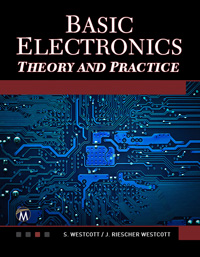 Basic Electronics
Basic Electronics
Theory and Practice
ISBN: 978-1-937585-41-9
Pub Date: December 2014
Specs: 7 x 9 Paperback with CD
Pages: 350
Price: $49.95
This book is an introduction appropriate for both the student and hobbyist to the theory and practice of electronics including advances in microcontrollers, sensors, and wireless communication. Covering both the theory and its practical application, this text leads the reader through introductory understanding of the science underlying electronics, building basic circuits, learning the roles of the components, the application of digital theory and the possibilities for innovation by combining sensors, motors, and microcontrollers. Each chapter contains a brief lab to demonstrate the topic covered then moving onto the final part which combines the knowledge mastered by building a programmable robot. The book includes appendices on Mathematics for Electronics, A Timeline of Electronics Innovation, Careers in Electronics, and a Glossary. The companion disc has videos of the labs, soldering skills, and code samples for programming of the robot.
Features
- Leads the reader through an introductory understanding of electronics with both simple labs and progressing to the construction of a microcontroller-driven robot using open source software and hardware
- Presents theoretical concepts in a conversational tone, followed by hands-on labs to engage readers by presenting practical applications
- Companion disc contains videos of all labs, tutorials on soldering/ de-soldering, code for the microcontroller robot project, and figures from the text
Brief Table of Contents
Part 1: The Fundamentals. Chapter 1: The Theory Behind Electricity. Chapter 2: How Electricity Works. Chapter 3: Currents and Circuits. Part 2: Your Workspace and Tools. Chapter 4: Tools of the Trade. Chapter 5: Shop Setup and Safety. Part 3: Electronic Components. Chapter 6: Switches. Chapter 7: Resistors. Chapter 8: Capacitors. Chapter 9: Diodes. Chapter 10: Transistors. Chapter 11: Power Sources and Power Supplies. Part 4: Getting to Work. Chapter 12: Soldering. Chapter 13: Constructing a Power Supply. Part 5: Going Digital. Chapter 14: Digital Theory. Chapter 15: Integrated Circuits. Chapter 16: Memory. Chapter 17: Microcontrollers. Part 6: Electronics in Action. Chapter 18: Motors and Controllers. Chapter 19: Sensors. Chapter 20: Electronic Communication. Part 7: Constructing a Robot. Chapter 21: Building Your Robot. Chapter 22: Getting Your Robot Moving. Chapter 23: Adding Sensors to Your Robot. Appendix A: Glossary. Appendix B: Component Shopping List. Appendix C: Electronics Timeline. Appendix D: Mathematics for Electronics. Appendix E: Careers in Electronics.
About the Authors
Sean Westcott is a network Administrator at MBP, Inc. His online writing can be found at Basementhackers.com. Jean Riescher Westcott is a Senior Marketing Manager at IPM. Her personal blog is DigitallyDaunted.com. They are both the authors of The Complete Idiot’s Guide to Electronic 101 (Alpha/Penguin Books).

